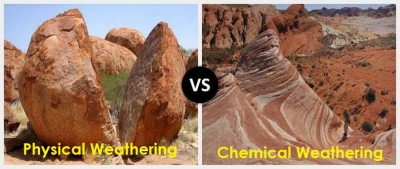
|
Physical weathering is also known as mechanical weathering. It is a process, initiated by humans, plants or animals, which breaks down rocks and minerals on the surface of Earth. It changes just the shape or size of the rocks and minerals. Chemical weathering, on the other hand, happens when the chemical composition of the rock and soil changes, forming new chemical combinations and a different internal structure. |
Physical weathering is also called as mechanical weathering. This is the process where rocks breakdown without altering their chemical composition. Physical weathering can occur due to temperature, pressure or snow. There are two main types of physical weathering. They are freeze thaw and exfoliation.
Freeze-thaw is the process where water goes into the cracks of the rock, then freezes and expands. This expansion causes rock to break apart. Changing temperature also causes rocks to expand and contract. When this happens over a period of time, rock parts starts to break down. Due to the pressure, cracks can be developed parallel to the land surface which leads to exfoliation.
Physical weathering is prominent in the places where there is little soil and few plants. For example, in desserts surface rocks are subjected to regular expansion and contraction due to temperature changes. Also, in mountain tops, snow keeps melting and freezing which causes physical weathering there.
Chemical weathering is the decomposition of rocks due to chemical reactions. This changes the composition of the rock. This often takes place when rain water reacts with minerals and rocks. Rain water is slightly acidic (due to dissolution of atmospheric carbon dioxide, carbonic acid is produced), and when the acidity increases chemical weathering also increases. With the global pollution, acid rains occur now, and this increases chemical weathering more than the natural rate.
Other than water, temperature is also important for chemical weathering. When the temperature is high, the weathering process is also high. This releases minerals and ions in rocks into surface waters. There are three main types as to how the chemical weathering occurs. They are solution, hydrolysis and oxidation. Solution is the removal of rock in solution due to acidic rain water. This is sometimes called carbonation process, since the rain water acidity is due to carbon dioxide. Hydrolysis is the breakdown of rock to produce clay and soluble salts by acidic water. Oxidation is the breakdown of rock due to oxygen and water.
Credit: differencebetween.com
Picture Credit : Google




